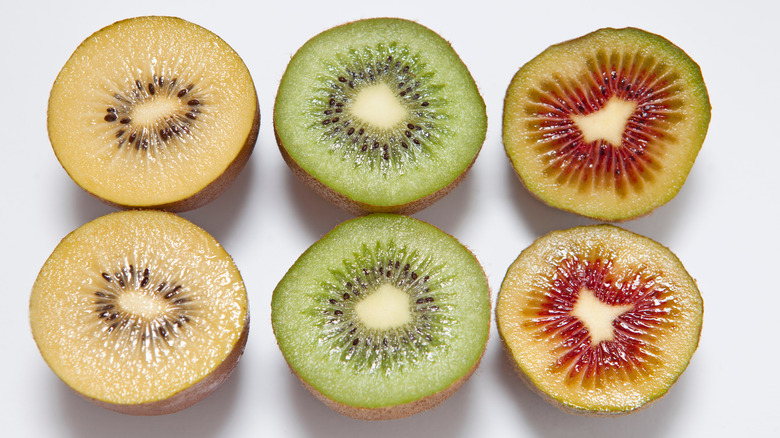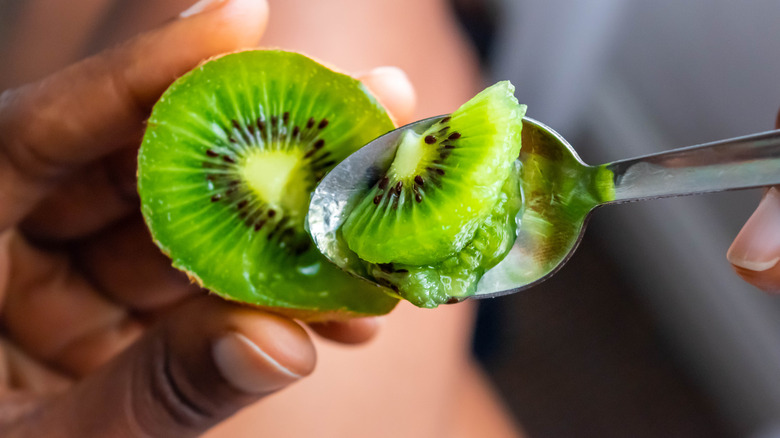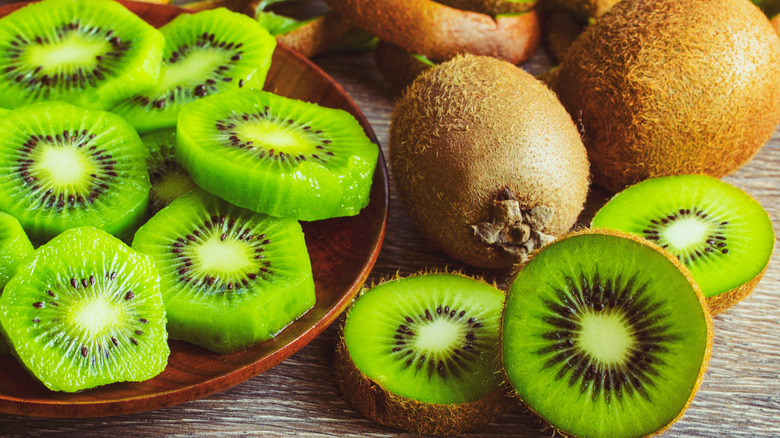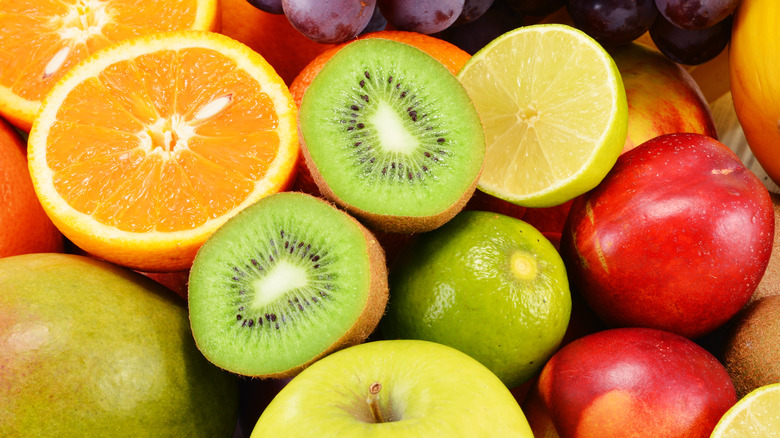What Is A Kiwi And How Do You Eat It?
The kiwi, properly known as a kiwifruit and oftentimes called the Chinese gooseberry, is indeed a large berry that grows on a thick, woody vine and is native to China, though it's also grown in New Zealand and California, according to Britannica. While kiwis have been consumed in Asia for several hundred years and became popular in New Zealand early in the 20th century, they were not well known around the globe until the years following WWII, says Purdue. At that time, American servicemen stationed in New Zealand grew fond of the tart little fruits, and soon kiwis were being exported to the United States, Europe, and beyond where they took off.
According to NewZealand.com, the name 'kiwi' comes from the curious little flightless bird that is unique to New Zealand. They have brown feathers that are much the same shade as the skin of the fruit and have a similar body shape. As the story goes, according to Planted Shack, in 1904, a teacher returning from at trip to China brought the fruit back to New Zealand and it became wildly popular, with the country adopting it as their fruit due to its resemblance to the native bird.
Today, the global kiwifruit market is worth nearly $8 billion in US dollars, according to Globe Newswire, with China still the leading consumer of their native fruit, followed by Italy and Iran. In recent years, an average of 4.4 million metric tons of kiwis have been produced annually. In 2019, the United States imported about 68 metric tons of kiwis (via Global Trade), and its popularity only continues to grow.
Here's the best way to eat a kiwi
When you get your kiwis home from the market and they are ready to be enjoyed, do you know how to really eat one? That is the million dollar question.
While you could peel it and then slice it and dice it like most other fruits, peeling a kiwi is a messy affair. Plus, it's really a waste of time. Or, you could just take a bite right into that brown fuzzy exterior. According to Healthline you actually can eat the skin safely — and doing so gives an extra dose of folate, fiber, and vitamin E — but you probably wouldn't enjoy it much.
The best way to eat a kiwi, according to many, including Taste Of Home, is to slice it in half, then use a spoon to dig in between the brown skin and interior flesh, working the spoon around the whole kiwi in a circle, then popping out the "meat" and slicing or dicing it. You can also scoop out smaller bites and eat them right from the skin, of course.
Once chopped up, kiwis are great in smoothies, salads, or even salsas. Like other fruits, they can be cooked down into jams or made into a cobbler too, recommends Have A Plant.
What does a kiwi taste like?
There are many different kinds of kiwi, according to Fruit Stand, and each one has a slightly different taste. Though, you will almost always see the green fuzzy kiwifruit for sale in the supermarket or produce store, especially in the United States. The flavor of a ripe kiwi is unique: there is a tartness not unlike a citrus fruit, a sweetness similar to that of pineapple, and a definite berry-like taste — something between a strawberry and raspberry.
The other variety of kiwi you may occasionally see for sale is the gold kiwifruit. The brown exterior skin of the gold kiwi is a bit smoother than that of the green variety — and as the name suggests, the interior is distinctly yellow, says Taste.com. Gold kiwis are less tart than green kiwis, and have a tropical flavor similar to a mango blended with a citrus fruit.
Like the edible skin, it is safe to eat the seeds and core of a kiwi, though the seeds can be a bit on the bitter side, so if you are making a smoothie or jam, take care not to blend or process a kiwi so much that the seeds pulverize.
When kiwis are in season and how to know if they're ripe
Kiwis are generally ready for harvest in the late fall, with November to January seeing peak availability, according to Planted Shack. However, you can find them year-round if you look a bit, especially given that kiwis are grown in China, New Zealand, Italy, California, and in other subtropical regions as well. If you want to grow your own kiwis, plan on patience. The vines take years to mature, and the fruit itself can take some 240 days to grow to readiness.
A ripe kiwi will feel solid and resilient, giving slightly as you squeeze the brown skin with your fingertip but returning to its shape without a dimple left behind. It will feel as heavy as you'd expect for a fruit saturated with fluid, says Taste.com, though it will have very little scent. If a kiwi is so firm it does not give in to a squeeze, it is not ripe yet. And if it looks bruised, dented, or dried out — or if it feels lighter than you expect — it is likely past its prime.
The possible health benefits of kiwis
Kiwis are packed with more than just great taste — they are also loaded with vitamins and minerals and are, in general, highly nutritious. According to Healthline, kiwifruits are a great source of vitamins C, E, and K, and they also deliver a good dose of folate and potassium. Like other fruits, kiwis are a great source of fiber that can aid digestive health.
Another great thing about kiwis is that they have antioxidants. And because of their high vitamin C concentration, they may be able to help reduce inflammation and support immune health. Some studies as noted by Healthline also suggest that regular consumption of kiwis may help reduce blood pressure and prevent blood clotting; as well, eating them may be able to stave off macular degeneration, which impairs eyesight and can even lead to blindness.
In rare cases, people may find they are allergic to kiwis, with symptoms including a pained or itchy throat, trouble swallowing, vomiting, a rash, and other complications. If you are allergic to latex, avocados, poppy seeds, or certain nuts, you may want to be wary with kiwis.




